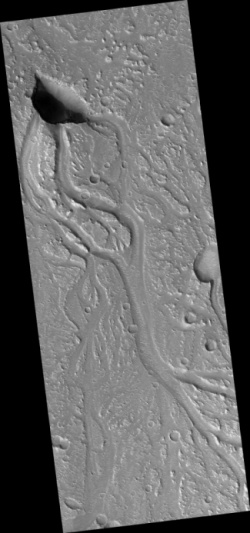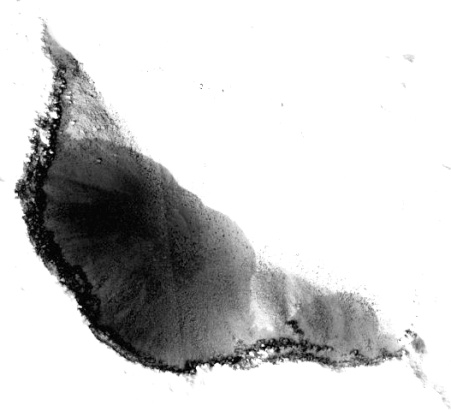A Martian sinkhole

Cool image time! The image on the right, reduced to display here, was taken by Mars Reconnaissance Orbiter and shows a very intriguing drainage pattern with several different meandering washes apparently flowing into what clearly looks like a sinkhole. As noted at the MRO website,
The drainages in this image are part of Hebrus Valles, an outflow channel system likely formed by catastrophic floods.
Hebrus Valles is located in the plains of the Northern lowlands, just west of the Elysium volcanic region. Individual channels range from several hundred meters to several kilometers wide and form multi-threaded (anastamosing) patterns. Separating the channels are streamlined forms, whose tails point downstream and indicate that channel flow is to the north. The channels seemingly terminate in an elongated pit that is approximately 1875 meters long and 1125 meters wide. Using the shadow that the wall has cast on the floor of the pit, we can estimate that the pit is nearly 500 meters deep.
To better see the shadowed floor of the sinkhole, I have cropped the full resolution image to focus on the pit itself, and increased the brightness significantly as shown on the right.

There does not appear to be any openings in the sinkhole floor into which water could drain, a lack that can be explained several ways. First, it is not unusual on Earth for sinkholes to have floors like this, without any obvious drainage opening, and for the water to still sink easily into the sand and rocks. Second, even if the drainage here is completely blocked, this could merely mean that it has been a very long time since water flowed here. When similar drainage systems dry up here on Earth, they fill with sediment and debris over time, so that all access to the cave below gets blocked. Many of the cave dig projects that I have been involved in over the last few decades were aimed precisely at digging out this debris to get access to the virgin cave below.
Either way, this Martian drainage indicates the presence of underground hydrology. Or to put it another way, water that future colonists can drill down into and access.
On Christmas Eve 1968 three Americans became the first humans to visit another world. What they did to celebrate was unexpected and profound, and will be remembered throughout all human history. Genesis: the Story of Apollo 8, Robert Zimmerman's classic history of humanity's first journey to another world, tells that story, and it is now available as both an ebook and an audiobook, both with a foreword by Valerie Anders and a new introduction by Robert Zimmerman.
The print edition can be purchased at Amazon or from any other book seller. If you want an autographed copy the price is $60 for the hardback and $45 for the paperback, plus $8 shipping for each. Go here for purchasing details. The ebook is available everywhere for $5.99 (before discount) at amazon, or direct from my ebook publisher, ebookit. If you buy it from ebookit you don't support the big tech companies and the author gets a bigger cut much sooner.
The audiobook is also available at all these vendors, and is also free with a 30-day trial membership to Audible.
"Not simply about one mission, [Genesis] is also the history of America's quest for the moon... Zimmerman has done a masterful job of tying disparate events together into a solid account of one of America's greatest human triumphs."--San Antonio Express-News

Cool image time! The image on the right, reduced to display here, was taken by Mars Reconnaissance Orbiter and shows a very intriguing drainage pattern with several different meandering washes apparently flowing into what clearly looks like a sinkhole. As noted at the MRO website,
The drainages in this image are part of Hebrus Valles, an outflow channel system likely formed by catastrophic floods.
Hebrus Valles is located in the plains of the Northern lowlands, just west of the Elysium volcanic region. Individual channels range from several hundred meters to several kilometers wide and form multi-threaded (anastamosing) patterns. Separating the channels are streamlined forms, whose tails point downstream and indicate that channel flow is to the north. The channels seemingly terminate in an elongated pit that is approximately 1875 meters long and 1125 meters wide. Using the shadow that the wall has cast on the floor of the pit, we can estimate that the pit is nearly 500 meters deep.
To better see the shadowed floor of the sinkhole, I have cropped the full resolution image to focus on the pit itself, and increased the brightness significantly as shown on the right.

There does not appear to be any openings in the sinkhole floor into which water could drain, a lack that can be explained several ways. First, it is not unusual on Earth for sinkholes to have floors like this, without any obvious drainage opening, and for the water to still sink easily into the sand and rocks. Second, even if the drainage here is completely blocked, this could merely mean that it has been a very long time since water flowed here. When similar drainage systems dry up here on Earth, they fill with sediment and debris over time, so that all access to the cave below gets blocked. Many of the cave dig projects that I have been involved in over the last few decades were aimed precisely at digging out this debris to get access to the virgin cave below.
Either way, this Martian drainage indicates the presence of underground hydrology. Or to put it another way, water that future colonists can drill down into and access.
On Christmas Eve 1968 three Americans became the first humans to visit another world. What they did to celebrate was unexpected and profound, and will be remembered throughout all human history. Genesis: the Story of Apollo 8, Robert Zimmerman's classic history of humanity's first journey to another world, tells that story, and it is now available as both an ebook and an audiobook, both with a foreword by Valerie Anders and a new introduction by Robert Zimmerman.
The print edition can be purchased at Amazon or from any other book seller. If you want an autographed copy the price is $60 for the hardback and $45 for the paperback, plus $8 shipping for each. Go here for purchasing details. The ebook is available everywhere for $5.99 (before discount) at amazon, or direct from my ebook publisher, ebookit. If you buy it from ebookit you don't support the big tech companies and the author gets a bigger cut much sooner.
The audiobook is also available at all these vendors, and is also free with a 30-day trial membership to Audible.
"Not simply about one mission, [Genesis] is also the history of America's quest for the moon... Zimmerman has done a masterful job of tying disparate events together into a solid account of one of America's greatest human triumphs."--San Antonio Express-News


Mr. Zimmerman: May you present an article, which gives a most recent status what present science believes about the whole “water story” at and of Mars, regarding its complete history up to present? Thank you in advance?
If you are asking me to write this, I may. However, if you want a quick idea of the present state of knowledge, simply use the search box on Behind the Black and type in “Mars water”. You will have hours of reading of the many many posts I have made on this subject over the years, and will soon get a pretty good idea of where our knowledge stands.
To sum it up quickly: We know liquid water once flowed on Mars. We do not know exactly when, or how long, or how deep. Nor do we really understand all the factors that caused that water to go away. Moreover, we do not know yet exactly how much of that water remains there, below the surface.
@Mr. Zimmerman: Thank you for short up-summing. Yes, I am asking you to do that writing and implementing your expertise that you gained all over the years. Thanks in advance.
We do not know exactly when, or how long, or how deep.
Well, my question was going to be if there was any dating on these water events.
In some cases you can see they flow around impact craters, so that would help if we had some people on the surface to do geology. Also, depending on when various flooding events took place, the atmosphere might not have allowed for liquid water to stick around for very long.
Either way, this Martian drainage indicates the presence of underground hydrology.
Yes. The megaflood(s) appear to have upwelled from beneath the surface of Mars.
Question: have you done Buckskin Gulch?
I’m guessing you must live in the South West judging from your canyoneering posts, we should get together one of these days for some desert adventure.
Me? I worked with Tom Meyer on the Mars Underground, then I was a founding member of Mars Society. Engineer, dirtbiker, cannoneer -er and hope to god I can retire one of these days!
SE Jones